|
|
Porsche Boxster
Debut: 1996
Maker: Porsche
Predecessor: 968 |
|
 Remember
the "good old days" of Porsche in the early and mid 80's ? In then, its
sales reached record-high at over 50,000 per year spread over the trio
- the straight four 944, the flat six 911 and the Vee eight 928. 3 cars
were adequately priced at different levels, aimed at different
customers
and have different characters. Particularly the 944 series, which
evolved
from 924 and won the heart of many young drivers by its superior
handling
and affordable price. However, since then the Japanese car makers
started
attack on the middle price coupe sector and the 944 continued losing
its
market. Remember
the "good old days" of Porsche in the early and mid 80's ? In then, its
sales reached record-high at over 50,000 per year spread over the trio
- the straight four 944, the flat six 911 and the Vee eight 928. 3 cars
were adequately priced at different levels, aimed at different
customers
and have different characters. Particularly the 944 series, which
evolved
from 924 and won the heart of many young drivers by its superior
handling
and affordable price. However, since then the Japanese car makers
started
attack on the middle price coupe sector and the 944 continued losing
its
market.
Porsche
faced the darkest days in the early 90's. Not only sales dropped to
below
15,000, 2 of the trio, 924/944/968 series and 928 died in 1994 after
several
years of slow sale. Ridiculously, the only survivor is the 911 series
which
was launched as early as 1963. Although in the recent couple of years,
911 became a great hit due to an unexplainable fashion, apparently it
would
be a risk to continue rely solely on it. Therefore the Porsche
management
decided to build another model which is smaller, lighter and less
costly
alongside with the 911. That is the Boxster, code name 986.
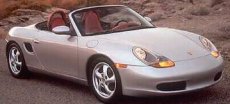 In
nowadays, developing a sports car with the perfect ability as Porsche
used
to require is a costly project. Since the competitors from other giant
car makers can base their Boxster-rivals on mass-produced sedan
platforms
(e.g., Mercedes SLK and BMW M Roadster), Boxster should also find
ways
to cut cost. Here Porsche adopt a very radical idea - simply replace
the
old 911 with a new one which could share as much as a third of the
components
used in the 986 ! I am not dare to say this will be good to the
legendary
911, but at least in Boxster side it is a good news. It makes Boxster
only
a little bit pricier than the 968 but the whole car is a lot more
desirable,
because the Boxster is a mid engine pure sports car with a beautiful
soft
top and a flat 6 engine. In
nowadays, developing a sports car with the perfect ability as Porsche
used
to require is a costly project. Since the competitors from other giant
car makers can base their Boxster-rivals on mass-produced sedan
platforms
(e.g., Mercedes SLK and BMW M Roadster), Boxster should also find
ways
to cut cost. Here Porsche adopt a very radical idea - simply replace
the
old 911 with a new one which could share as much as a third of the
components
used in the 986 ! I am not dare to say this will be good to the
legendary
911, but at least in Boxster side it is a good news. It makes Boxster
only
a little bit pricier than the 968 but the whole car is a lot more
desirable,
because the Boxster is a mid engine pure sports car with a beautiful
soft
top and a flat 6 engine.
It
is the first all new model in 20 years (since the 928 in 1978). As
every
Porsche is supposed to serve for at least a decade, the engineers
applied
radical layout - Mid-mounted 24 valves flat six (now finally becomes
water-cooled) with variable valve timing. Such specification will not
limit the
evolution
in the foreseeable future. However, the small engine capacity (2.5
litres) and less-impressive specific output (82 hp / litre) plus the
mere 5
speed manual box means that "This is only the beginning !" and
preserves
room for improvement in the future. Therefore the Boxster is not much
faster
than Mercedes SLK and will be definitely slower than the BMW M
Roadster.
It tops 139 mph and finish 0-60mph in 6.5 sec, which release the
pressure
on the new 911.
 Nevertheless,
as many real drivers know, handling is the more-appropriate criterior
to
judge a sports car. In this respect, Boxster's superior balance,
steering
accuracy, steering feel, grip, brakes and the aid from the highly
flexible
engine make it to be one of the best handling sports car ever made. No
matter drive it fiercely or drive it with ease, you can always
experience
high level of pleasure and fun. Any SLK and M Roadster will feel shame
to compare with it. Nevertheless,
as many real drivers know, handling is the more-appropriate criterior
to
judge a sports car. In this respect, Boxster's superior balance,
steering
accuracy, steering feel, grip, brakes and the aid from the highly
flexible
engine make it to be one of the best handling sports car ever made. No
matter drive it fiercely or drive it with ease, you can always
experience
high level of pleasure and fun. Any SLK and M Roadster will feel shame
to compare with it.
If
you ask me whether Lotus Elise or Boxster has the best handling in
roadster,
I'll tell you it is the Elise. Nevertheless, Elise is a raw machine
with
an uninspiring engine, while Porsche refine in anywhere and its flat
six
is willing, smooth and sings beautiful songs. The Boxster is a perfect
all-round sports car.
How
all-round ? Look at the stylish cabin, excellent driving position,
perfect
painting and build quality, the fast-operating electric hood and the
traditional
Porsche exterior styling (or simply "911 look") and you will agree
that
it is a perfect car with no short.
|
| The
above report was last updated in 1998. All Rights Reserved. |
|
986 Boxster S
|
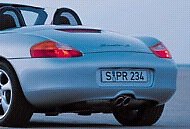 Here
comes an engine the Boxster deserves - a 3.2-litre unit pumping up from
the original 2.5-litre, with 252 hp and 225 lbft. But is it really
enough
? Here
comes an engine the Boxster deserves - a 3.2-litre unit pumping up from
the original 2.5-litre, with 252 hp and 225 lbft. But is it really
enough
?
The 911
Carrera
pumps out
a full 300hp from just 200c.c. in-excess of the Boxster. Both units
feature
VVT, electronic throttle and 2-stage variable length induction
manifold,
so why the 911 has a specific output of 87hp/litre while the newer
Boxster
engine achieves just 79hp/litre ? Remember just 3 months ago the 911GT3
broke the 100hp/litre barrier.
For
marketing
reasons, of
course. By deliberately detuned the 911’s flat six, losing a little bit
displacement and more efficiency, the 3.2-litre Boxster S has the power
exactly in midway between the base Boxster and the 911 Carrera. On one
hand this should satisfy those complaining the Boxster as slower than
many
competitors, on the other hand the flagship 911 can remains earning
superior
profit without worrying internal competition. For you reference, the
911
Carrera reaches 60mph in 4.6sec and then 100mph in 10.5sec; the Boxster
S does this in 5.7 sec and 14.2sec respectively. Whether this justify
the
extra 50% cost depends on your point of view.
 We
can imagine that Porsche can easily make a 285hp Boxster without
needing
increase the engine capacity if it feels necessary. However, we must
accept
the fact that Boxster S has "only" 252 horsepower. Even with "just"
252hp,
Boxster at least matches its nearest competitors, namely Honda S2000
and
Lotus Elise 111S. Although Autocar magazine measured a disappointing
0-60mph
of 6.0 sec, which is less believable than Porsche’s traditional honest
claims, the 0-100mph time of 14.2sec edges out the S2000’s 14.3sec and
Elise’s 14.8sec. And undoubtedly, the superior torque delivery of the
3.2-litre
boxer engine is not comparable by Honda’s 2.0 VTEC and Elise’s 1.8 VVC. We
can imagine that Porsche can easily make a 285hp Boxster without
needing
increase the engine capacity if it feels necessary. However, we must
accept
the fact that Boxster S has "only" 252 horsepower. Even with "just"
252hp,
Boxster at least matches its nearest competitors, namely Honda S2000
and
Lotus Elise 111S. Although Autocar magazine measured a disappointing
0-60mph
of 6.0 sec, which is less believable than Porsche’s traditional honest
claims, the 0-100mph time of 14.2sec edges out the S2000’s 14.3sec and
Elise’s 14.8sec. And undoubtedly, the superior torque delivery of the
3.2-litre
boxer engine is not comparable by Honda’s 2.0 VTEC and Elise’s 1.8 VVC.
 With
extra power and torque, the long sleeping potential of the chassis
could
be fully exploited. The Boxster now has sufficient power to oversteer
the
rear tyres so that it is more adjustable in corner. The basic steering
tendency remains to be mild understeer most of the time. The wonderful
steering feel remains unchanged. Porsche is so confident that it made
no
modification other than slightly revising the rear suspension geometry
and installing firmer springs / dampers to cope with the extra 45kg
kerb
weight as well as the increased cornering speed. Oh yes, it also
adopted
911’s brakes and 6-speed gearbox, the former indicating that the
Boxster
S stops even faster than his elder brother. With
extra power and torque, the long sleeping potential of the chassis
could
be fully exploited. The Boxster now has sufficient power to oversteer
the
rear tyres so that it is more adjustable in corner. The basic steering
tendency remains to be mild understeer most of the time. The wonderful
steering feel remains unchanged. Porsche is so confident that it made
no
modification other than slightly revising the rear suspension geometry
and installing firmer springs / dampers to cope with the extra 45kg
kerb
weight as well as the increased cornering speed. Oh yes, it also
adopted
911’s brakes and 6-speed gearbox, the former indicating that the
Boxster
S stops even faster than his elder brother.
The
styling of
Boxster S
differs very little from the base Boxster - there is a third air intake
at the middle of the nose to draw air to the third radiator, hence drag
coefficient is raised from 0.31 to 0.32. At the back, twin-pipe exhaust
replaces the single pipe, still locates at the middle of the rear. The
cabin now is surrounded by high quality plastic, some painted in
aluminium
colour. Standard equipment level has been upgraded.
|
| The
above report was last updated on 8 Aug 99. All Rights Reserved. |
|
986 Boxster 2.7
|
Does the
Boxster 2.7 has enough bite to defend its title from Honda S2000 ? Wait
a moment. I don’t think the S2000 has beaten the original Boxster,
especially
is that it has far better steering feel, but still there are many
people
asking Porsche to give its entry level car more power, and perhaps the
arrival of S2000 has exerted a healthy pressure to the engineers in
Weissach,
pushing them to make even better machines.
Of course not.
Porsche has
planned and tested the 2.7-litre version of its flat-six since long
ago.
According to its tradition, you won’t expect a huge power jump for the
new version, but Porsche will give you just enough. The displacement of
2687c.c. was made by means of lengthening the stroke to the same 78mm
as
the Boxster S. Therefore they share the same connecting rods. Besides,
two-stage variable intake manifolds is added to improve mid range
torque.
Electronic throttle is adopted.
Instead of
204hp
and 181
lbft, the enlarged engine pumps out 220 hp and 192 lbft (upated: this
rise
again to 228hp in year 2002, thanks to the adoption of a new Variocam).
Not big numbers, but in reality the difference is more than that. From
4,000rpm to 7,000rpm, the increase of punch is more noticeable, as seen
by the 0-100mph of 15.5 sec. That is far quicker than the old car’s
18.0
sec and not far behind Boxster S’s 14.2 sec. What a pity it still drive
through a 5-speed manual from the old car, without Boxster S’s
6-speeder
to choose from.
Nevertheless,
the
5-speed
unit is as delight to be shifted as ever. The superb chassis is still
there,
covering with the same pretty enclosure (that said, nothing’s changed
other
than the engine). The additional punch gives the driver more
opportunity
to enjoy the at-the-limit balance and communication of the wonderful
chassis.
The
bottom line
is, Porsche
has cured the only weak link in the Boxster. Without raising the price
(considering equipment level is upped.), the new Boxster 2.7 should
settle
the embarrassment facing by the old Boxster since the arrival of Honda
S2000.
|
| The
above report was last updated on 29 Nov 99. All Rights Reserved. |
|
2002 power upgrade
|
In
2002, both boxer engines received a new version of
Variocam. You might remember, the outgoing Variocam adjusted cam
phasing by means of timing chain. This limited its range of adjustment
to 25 degrees, and the adjustment was implemented in 3 stages. The new
Variocam system used a hydraulic actuator at the end of the intake
camshaft to vary cam phasing infinitely for a range of 40 degrees. As a
result, both the 2.7 and 3.2 engine had their output lifted by 8hp,
resulting in 228hp and 260hp respectively.
|
| The
above report was last updated on 12 Aug 2009. All Rights Reserved. |
|
987 Boxster and Boxster S
|
 After
serving for 8 long years, Porsche Boxster finally received a major
makeover.
Codenamed 987, the new Boxster is not exactly a complete redesign, as
you
can already guess from the photos. Although 80% of the components are
new,
all the hard points and basic layout remains unchanged. Externally, the
most obvious change is the reshaped headlamps, bumpers and air intakes.
Otherwise it remains loyal to the 986 design. Disappointingly, the
over-long
front and rear overhangs are carried over from the old car, making the
Boxster looking less modern than rivals. After
serving for 8 long years, Porsche Boxster finally received a major
makeover.
Codenamed 987, the new Boxster is not exactly a complete redesign, as
you
can already guess from the photos. Although 80% of the components are
new,
all the hard points and basic layout remains unchanged. Externally, the
most obvious change is the reshaped headlamps, bumpers and air intakes.
Otherwise it remains loyal to the 986 design. Disappointingly, the
over-long
front and rear overhangs are carried over from the old car, making the
Boxster looking less modern than rivals.
The
new Boxster
is about
the same size as before, but a boost of 20mm in width is a welcomed
news,
because it allows wider tracks to improve handling. On the other hand,
chassis rigidity is up by 9% due to reinforced floorpan and stronger
spot
welding. Thanks to careful weight control (among which is the
introduction
of aluminum boot lid and magnesium frame for hood cover), the Boxster
gains
just 20kg. This already includes the new variable-ratio power steering
and PASM adaptive damping, both come from the new 911, a car it shares
30% components. Outside, drag coefficient is lowered from 0.31 to 0.29,
along with increased downforce (thanks to a rear spoiler that raises
slightly
higher). These changes are not big, but every aspect of the car has
been
polished and improved.
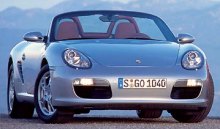 More
important, the new Boxster gets more power to fight against BMW Z4 3.0
and Mercedes SLK350 etc. By smoothening air filter, intake manifolds
and
reducing exhaust backpressure, now both the Boxster and Boxster S get
considerable
power increase, even though without altering engine capacity. Output of
the standard 2.7-litre boxer engine is increased from 228hp to 240hp,
while
the 3.2-litre engine for Boxster S is up from 260hp to 280hp. More
important, the new Boxster gets more power to fight against BMW Z4 3.0
and Mercedes SLK350 etc. By smoothening air filter, intake manifolds
and
reducing exhaust backpressure, now both the Boxster and Boxster S get
considerable
power increase, even though without altering engine capacity. Output of
the standard 2.7-litre boxer engine is increased from 228hp to 240hp,
while
the 3.2-litre engine for Boxster S is up from 260hp to 280hp.
Nevertheless,
the
Boxster
is still slower and less punchy than its biggest rival Mercedes SLK350.
Autocar found it needs 6.1 seconds to accelerate to 60 mph and 15.1
seconds
to 100 mph. The SLK takes just 5.5 sec and 13.1 sec respectively.
That's
not in the same league at all. Although the Boxster is almost 100kg
lighter
than the Mercedes, its smaller engine capacity and 5-speed-only gearbox
account for the difference.
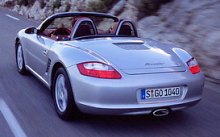 Naturally,
Boxster S is much faster - it takes 5.2 seconds to 60 mph and tops 167
mph. The 280hp boxer is an engine it deserves, so is the new,
slicker-shifting
6-speed gearbox from the 997. However, being 20% more expensive than
the
2.7 Boxster, it competes in the league of Chevrolet Corvette instead.
Tick
a few necessary options and the must-have PCCB ceramic brakes, it is
already
in the price range of Mercedes SLK55 AMG. The fact is, Porsche Boxster
never returns very good "Bang for the Buck". Naturally,
Boxster S is much faster - it takes 5.2 seconds to 60 mph and tops 167
mph. The 280hp boxer is an engine it deserves, so is the new,
slicker-shifting
6-speed gearbox from the 997. However, being 20% more expensive than
the
2.7 Boxster, it competes in the league of Chevrolet Corvette instead.
Tick
a few necessary options and the must-have PCCB ceramic brakes, it is
already
in the price range of Mercedes SLK55 AMG. The fact is, Porsche Boxster
never returns very good "Bang for the Buck".
However,
if you
pursue engineering
excellence and the ultimate driving fun, there is still no replacement
for the Boxster, especially Boxster S. The perfect balance of its
mid-engined
chassis, the low weight, the intimate steering, the sharp turn-in, the
massive grip, the beautifully weighted controls, the
confidence-inspiring
braking, the sweet gearchange, the turbine-smooth flat-6, the lovely
voice
of the boxer… all point to the most engaging driving experience any
money
can buy - not even 997 or F430. Behind that is a compliant ride that
only
Mercedes' roadster can match. This car is simultaneously your everyday
car and your funniest toy.
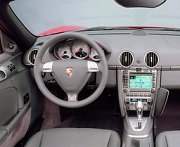 Compare
with the old Boxster, 987 improves in every aspect - speed, handling,
braking
and damping. The changes might be small, but the accumulative effect is
apparent. Compare
with the old Boxster, 987 improves in every aspect - speed, handling,
braking
and damping. The changes might be small, but the accumulative effect is
apparent.
Any
weaknesses?
there are
a few. As in the new 911, its variable ratio steering feels somewhat
numb
at the straight-ahead, a price it paid to enhance cruising refinement.
It takes 30° to overcome the numbness, and gets better the more you
turn the wheel. Luckily this does not affect the entertaining way it
attacks
corners.
Another
weakness
is the dull-looking
new dashboard and center console. Although we applause for the improved
built and material quality, it deserves a more stylish design to match
its rivals.
But
on the top of
the wish
list remains to be a more powerful engine. Porsche always afraid a more
powerful Boxster could hurt the sales of its more profitable 911. But
the
Boxster chassis is actually better than the 911 and it deserves more
power.
Driven by Walter Rohl, the Boxster S lapped Nurburgring at 8min 18sec,
or 9 second quicker than the old car. Is it fast enough? the answer is
certainly negative to many Porsche fans. We hope Porsche could consider
transplanting the 3.6 or even 3.8 engine of the 911 to create a super
Boxster,
especially in the presence of Mercedes SLK55 AMG.
|
| The
above report was last updated on 29 Jan 2005. All Rights Reserved. |
|
2006 power upgrade
|
Porsche
Boxster is getting the more powerful engines from Cayman. The company
has announced that the base Boxster 2.7 will be upgraded to 245hp and
201lbft (up from 240hp and 199lbft) like the recently introduced base
Cayman, while Boxster S will have its 280hp / 236lbft 3.2-litre engine
replaced by Cayman S' 295hp / 251lbft 3.4-litre unit. Both engines are
benefited by 911's VarioCam Plus system, i.e., with the addition of
2-step variable valve lift.
The Boxster 2.7 is now capable of 160mph and 0-60 in 5.8 sec, while
figures for Boxster S are 169mph and 5.1 sec.
|
| The
above report was last updated on 20 Jun 2006. All Rights Reserved. |
|
2009 Boxster update
|
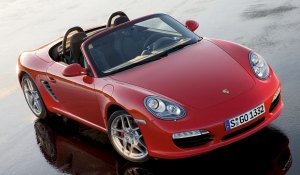
|
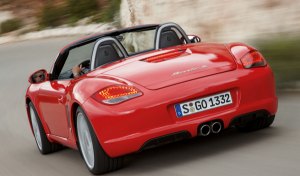 |
|
Having
read my report on the Cayman update, you can go through this article
quickly. Basically, the new Boxster shares nearly all the mechanical
changes found in its sister car, such as the availability of PDK
twin-clutch gearbox, limited slip differential, an upgraded satellite
navigation system and more powerful engines. What about the facelift ?
You can spot the minor differences from these pictures.
The base Boxster is now powered by a larger 2.9-liter boxer, while
Boxster S gets a new 3.4-liter engine with direct injection and shorter
stroke. However, Porsche continues its policy to position the Boxster
below Cayman, so the engine management systems in both Boxsters are
deliberately remapped to limit their top end output. The 2.9 engine
here produces 255 hp at 6400 rpm, versus 265 hp at 7200 rpm on Cayman.
The 3.4 engine generates 310 hp at 6400 rpm instead of 320 hp at 7200
rpm. Their maximum torque are also slightly lower than that of the
Caymans. Still, performance is slightly improved over the old car. A
Boxster S with PDK gearbox can accelerate from 0-60 mph in 5 seconds
flat, or 4.9 seconds with optional Sport Plus package which provides
launch control. At the same time, fuel consumption is dropped by around
3 mpg.
Sure, many cars are faster yet cost
less money, but I suppose there are still no one else in the roadster
field can provide the same combination of handling, ride, usability and
build quality as the entry-level Porsche.
|
| The
above report was last updated on 24 Dec 2008. All Rights Reserved. |
|
Boxster Spyder
|
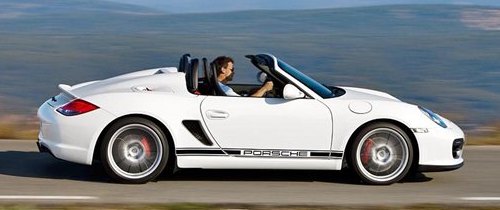
|
This is actually a better driver's car
than the GT3...
|
Striped
out open-top sports car is not a new idea to Porsche. In the 1950s, it
created 356 Speedster and 550 Spyder. However, that breed was not
properly followed as 911 started dominating the scene. Each generation
911 got heavier, more powerful, better equipped and as a result more
expensive. Lightweight Porsches became limited to the high-end 911 RS
or GT3. The only exception was 968CS (Clubsport), which brought
lightweight fun back to the entry-level model and thrilled thousands of
loyal owners.
When Boxster was launched in 1996, it was considered to be a baby
Porsche fulfilling the role left by 968. Yet to the disappointment of
us, it has never been giving a lightweight and hardcore treatment like
986CS. What a pity, because there is definitely space for such a
Boxster to live. It would certainly deliver the same sharp handling as
911 GT3, ultimately not as quick as its bigger brother but should be
way cheaper. It would appeal to different kind of customers, especially
those who would otherwise purchase Lotus Exige or other track specials.
Perhaps God has listened to our prayers, Porsche has finally produced
this car – Boxster Spyder.
Boxster Spyder is a lightweight version of Boxster S. It isn't much
more powerful than the latter – just 10 extra horsepower at the top
end, thanks to adopting the Cayman S-spec engine. You won't call a
320hp engine as weak, but the chassis can definitely take more.
Nevertheless, the highlight here is the lightweight treatment and
chassis modifications. Some 80 kg has been removed thanks to various
efforts, for example, a lightweight manually operated soft top,
lightweight bucket seats, aluminum doors (they come straight from 911
GT3 and Turbo), aluminum rear deck, a fixed rear spoiler and smaller
side windows. It also gets rid of air conditioning, audio system, door
handles (replaced by fabric pulls), door pockets and cup holders. The
19-inch alloy wheels are lighter than the standard 18-inch items. Even
the oil tank is smaller. The result is a kerb weight of 1275 kg. When
was the last time you heard a 300-horsepower-plus production car
weighing less than 1300 kg ?
Specifying PDK gearbox will add 25 kg but, with its quicker shift and
exclusive launch control, 0-60 mph can be shortened from 4.9 to 4.6
seconds. However, the 6-speed manual brings more engagement and higher
satisfaction with its short and slick gearchange. It is more in line
with the character of this car.
The lightweight fabric roof is not only smaller but more fragile. It is
not designed to withstand airflow exceeding 124 mph, so for high-speed
run you will need to leave it open. As a result, top speed is reduced
slightly to 166 mph.
Thanks to its double-dome rear deck, the Spyder looks like a
mini-Carrera GT. On the road, it also handles and rides like so. The
lightweight, together with stiffer suspensions, fixed rate dampers (no
PASM here), standard-fit LSD and 25 mm lower center of gravity (thanks
to 20mm drop of ride height, lighter roof and engine lid) translate to
sharper handling. Steering response and feel, body control and grip are
all raised to higher level. With better balance and a more benign
character at the limit, the Boxster Spyder is actually a better
driver's car than the GT3, although it lacks the firepower of the
latter. At the same time, its ride quality remains very good, thanks to
the reduced unsprung weight.
Good news is, the Spyder is not a limited edition like 911 Sport
Classic, but a permanent production model sitting alongside Boxster and
Boxster S. It commands a price about 10 percent higher than Boxster S,
which is comfortably below the level of 911. That said, Porsche expects
only 10 percent of all Boxster sales will go to the Spyder, as its
Spartan interior and roof are not everybody can live with.
|
| The
above report was last updated on 10 Dec 2009. All Rights Reserved. |
| Specifications
|
| General remarks |
| Layout |
| Chassis |
| Body |
| Length / width / height |
| Wheelbase |
| Engine |
| Capacity |
Valve gears
|
| Induction |
| Other engine features |
| Max power |
| Max torque |
| Transmission |
Suspension layout
|
| Suspension features |
Tires
|
| Kerb weight |
| Top speed |
| 0-60 mph (sec) |
| 0-100 mph (sec) |
|
| 986 Boxster 2.5 (1996) |
Mid-engined, RWD
|
| Steel monocoque |
| Mainly steel |
| 4318 / 1778 / 1295 mm |
| 2415 mm |
| Flat-6 |
| 2480 cc |
DOHC 24 valves, VVT
(3-stage Variocam)
|
| - |
| - |
204 hp
|
181 lbft
|
5-speed manual
|
All struts
|
| - |
F: 205/55ZR16
R: 225/50ZR16
|
| 1242 kg |
| 149 mph (c) |
| 6.5* |
| 18.0* |
|
| 986 Boxster 2.7 (1999) |
Mid-engined, RWD
|
| Steel monocoque |
| Mainly steel |
| 4318 / 1778 / 1295 mm |
| 2415 mm |
| Flat-6 |
| 2687 cc |
DOHC 24 valves, VVT
(3-stage Variocam)
|
| VIM |
| - |
220 hp
|
192 lbft
|
5-speed manual
|
All struts
|
| - |
F: 205/55ZR16
R: 225/50ZR16
|
| 1250 kg |
| 155 mph (c) |
| 6.4* |
| 15.5* |
|
| 986 Boxster S 3.2 (1999) |
Mid-engined, RWD
|
| Steel monocoque |
| Mainly steel |
| 4318 / 1778 / 1295 mm |
| 2415 mm |
| Flat-6 |
| 3179 cc |
DOHC 24 valves, VVT
(3-stage Variocam)
|
| VIM |
| - |
252 hp
|
225 lbft
|
6-speed manual
|
All struts
|
| - |
F: 205/50ZR17
R: 255/40ZR17
|
| 1295 kg |
| 161 mph (c) |
6.0* / 5.5** / 5.2***
|
| 14.2* / 13.7** / 13.6*** |
|
| General remarks |
| Layout |
| Chassis |
| Body |
| Length / width / height |
| Wheelbase |
| Engine |
| Capacity |
Valve gears
|
| Induction |
| Other engine features |
| Max power |
| Max torque |
| Transmission |
Suspension layout
|
| Suspension features |
Tires
|
| Kerb weight |
| Top speed |
| 0-60 mph (sec) |
| 0-100 mph (sec) |
|
| 986 Boxster 2.7 (2002) |
Mid-engined, RWD
|
| Steel monocoque |
| Mainly steel |
| 4318 / 1778 / 1295 mm |
| 2415 mm |
| Flat-6 |
| 2687 cc |
DOHC 24 valves, VVT
(continuous Variocam)
|
| VIM |
| - |
228 hp
|
192 lbft
|
5-speed manual
|
All struts
|
| - |
F: 205/55ZR16
R: 225/50ZR16
|
| 1275 kg |
| 157 mph (c) |
6.3*
|
| 15.2* |
|
| 986 Boxster S 3.2 (2002) |
Mid-engined, RWD
|
| Steel monocoque |
| Mainly steel |
| 4318 / 1778 / 1295 mm |
| 2415 mm |
| Flat-6 |
| 3179 cc |
DOHC 24 valves, VVT
(continuous Variocam)
|
| VIM |
| - |
260 hp
|
225 lbft
|
6-speed manual
|
All struts
|
| - |
F: 205/50ZR17
R: 255/40ZR17
|
| 1320 kg |
| 164 mph (c) |
5.4*****
|
| 15.2***** |
|
| 987 Boxster 2.7 (2005) |
Mid-engined, RWD
|
| Steel monocoque |
| Mainly steel |
| 4329 / 1801 / 1295 mm |
| 2415 mm |
| Flat-6 |
| 2687 cc |
DOHC 24 valves, VVT
(continuous Variocam)
|
| VIM |
| - |
240 hp
|
199 lbft
|
5-speed manual
|
All struts
|
| - |
F: 205/55ZR17
R: 235/50ZR17
|
| 1295 kg |
| 159 mph (c) |
6.1*
|
14.1*
|
|
| General remarks |
| Layout |
| Chassis |
| Body |
| Length / width / height |
| Wheelbase |
| Engine |
| Capacity |
Valve gears
|
| Induction |
| Other engine features |
| Max power |
| Max torque |
| Transmission |
Suspension layout
|
| Suspension features |
Tires
|
| Kerb weight |
| Top speed |
| 0-60 mph (sec) |
| 0-100 mph (sec) |
|
| 987 Boxster S 3.2 (2005) |
Mid-engined, RWD
|
| Steel monocoque |
| Mainly steel |
| 4329 / 1801 / 1295 mm |
| 2415 mm |
| Flat-6 |
| 3179 cc |
DOHC 24 valves, VVT
(continuous Variocam)
|
| VIM |
| - |
280 hp
|
236 lbft
|
6-speed manual
|
All struts
|
| - |
F: 235/40ZR18
R: 265/40ZR18
|
| 1345 kg |
| 167 mph (c) |
5.0** / 5.4****
|
| 12.2** / 13.1**** |
|
| 987 Boxster 2.7 (2006) |
Mid-engined, RWD
|
| Steel monocoque |
| Mainly steel |
| 4329 / 1801 / 1295 mm |
| 2415 mm |
| Flat-6 |
| 2687 cc |
DOHC 24 valves, VVT+VVL
(Variocam Plus)
|
| VIM |
| - |
245 hp
|
201 lbft
|
5-speed manual
|
All struts
|
| - |
F: 205/55ZR17
R: 235/50ZR17
|
| 1305 kg |
| 160 mph (c) |
5.9 (c)
|
14.2 (c)
|
|
| 987 Boxster S 3.4 (2006) |
Mid-engined, RWD
|
| Steel monocoque |
| Mainly steel |
| 4329 / 1801 / 1295 mm |
| 2415 mm |
| Flat-6 |
| 3387 cc |
DOHC 24 valves, VVT+VVL
(Variocam Plus)
|
| VIM |
| - |
295 hp
|
251 lbft
|
6-speed manual
|
All struts
|
| - |
F: 235/40ZR18
R: 265/40ZR18
|
| 1355 kg |
| 169 mph (c) |
5.2 (c) / 4.9***
|
11.8 (c) / 11.5***
|
|
| General remarks |
| Layout |
| Chassis |
| Body |
| Length / width / height |
| Wheelbase |
| Engine |
| Capacity |
Valve gears
|
| Induction |
| Other engine features |
| Max power |
| Max torque |
| Transmission |
Suspension layout
|
| Suspension features |
Tires
|
| Kerb weight |
| Top speed |
| 0-60 mph (sec) |
| 0-100 mph (sec) |
|
| 987 Boxster 2.9 (2009) |
Mid-engined, RWD
|
| Steel monocoque |
| Mainly steel |
| 4329 / 1801 / 1295 mm |
| 2415 mm |
| Flat-6 |
| 2893 cc |
DOHC 24 valves, VVT+VVL
(Variocam Plus)
|
| VIM |
| - |
255 hp / 6400 rpm
|
214 lbft / 4400-6000 rpm
|
6-speed manual
|
All struts
|
| - |
F: 205/55ZR17
R: 235/50ZR17
|
1335 kg
|
| 163 mph (c) |
5.7 (c)
|
13.6 (c)
|
|
| 987 Boxster S 3.4 (2009) |
Mid-engined, RWD
|
| Steel monocoque |
| Mainly steel |
| 4329 / 1801 / 1295 mm |
| 2415 mm |
| Flat-6 |
| 3436 cc |
DOHC 24 valves, VVT+VVL
(Variocam Plus)
|
| VIM |
| DI |
310 hp / 6400 rpm
|
265 lbft / 4400-5500 rpm
|
7-speed twin-clutch (or 6M)
|
All struts
|
| - |
F: 235/40ZR18
R: 265/40ZR18
|
1380 kg (6M: 1355 kg)
|
| 169 mph (c) |
5.0 (c) / 4.3***
|
11.4 (c) / 10.7***
|
|
| 987 Boxster Spyder |
Mid-engined, RWD
|
| Steel monocoque |
| Mainly steel |
| 4342 / 1801 / 1274 mm |
| 2415 mm |
| Flat-6 |
| 3436 cc |
DOHC 24 valves, VVT+VVL
(Variocam Plus)
|
| VIM |
| DI |
320 hp / 7200 rpm
|
273 lbft / 4750 rpm
|
6-speed manual (or 7-sp PDK)
|
All struts
|
| - |
F: 235/35ZR19
R: 265/35ZR19
|
1275 kg (PDK: 1300 kg)
|
| 166 mph (c) |
4.9 (c)
|
-
|
|
|
Performance
tested by: *Autocar, ***R&T,
***C&D, ****Automobile, *****MT
|
Copyright©
1997-2009
by Mark Wan @ AutoZine
|
|
|
 Remember
the "good old days" of Porsche in the early and mid 80's ? In then, its
sales reached record-high at over 50,000 per year spread over the trio
- the straight four 944, the flat six 911 and the Vee eight 928. 3 cars
were adequately priced at different levels, aimed at different
customers
and have different characters. Particularly the 944 series, which
evolved
from 924 and won the heart of many young drivers by its superior
handling
and affordable price. However, since then the Japanese car makers
started
attack on the middle price coupe sector and the 944 continued losing
its
market.
Remember
the "good old days" of Porsche in the early and mid 80's ? In then, its
sales reached record-high at over 50,000 per year spread over the trio
- the straight four 944, the flat six 911 and the Vee eight 928. 3 cars
were adequately priced at different levels, aimed at different
customers
and have different characters. Particularly the 944 series, which
evolved
from 924 and won the heart of many young drivers by its superior
handling
and affordable price. However, since then the Japanese car makers
started
attack on the middle price coupe sector and the 944 continued losing
its
market. In
nowadays, developing a sports car with the perfect ability as Porsche
used
to require is a costly project. Since the competitors from other giant
car makers can base their Boxster-rivals on mass-produced sedan
platforms
(e.g., Mercedes SLK and BMW M Roadster), Boxster should also find
ways
to cut cost. Here Porsche adopt a very radical idea - simply replace
the
old 911 with a new one which could share as much as a third of the
components
used in the 986 ! I am not dare to say this will be good to the
legendary
911, but at least in Boxster side it is a good news. It makes Boxster
only
a little bit pricier than the 968 but the whole car is a lot more
desirable,
because the Boxster is a mid engine pure sports car with a beautiful
soft
top and a flat 6 engine.
In
nowadays, developing a sports car with the perfect ability as Porsche
used
to require is a costly project. Since the competitors from other giant
car makers can base their Boxster-rivals on mass-produced sedan
platforms
(e.g., Mercedes SLK and BMW M Roadster), Boxster should also find
ways
to cut cost. Here Porsche adopt a very radical idea - simply replace
the
old 911 with a new one which could share as much as a third of the
components
used in the 986 ! I am not dare to say this will be good to the
legendary
911, but at least in Boxster side it is a good news. It makes Boxster
only
a little bit pricier than the 968 but the whole car is a lot more
desirable,
because the Boxster is a mid engine pure sports car with a beautiful
soft
top and a flat 6 engine. Nevertheless,
as many real drivers know, handling is the more-appropriate criterior
to
judge a sports car. In this respect, Boxster's superior balance,
steering
accuracy, steering feel, grip, brakes and the aid from the highly
flexible
engine make it to be one of the best handling sports car ever made. No
matter drive it fiercely or drive it with ease, you can always
experience
high level of pleasure and fun. Any SLK and M Roadster will feel shame
to compare with it.
Nevertheless,
as many real drivers know, handling is the more-appropriate criterior
to
judge a sports car. In this respect, Boxster's superior balance,
steering
accuracy, steering feel, grip, brakes and the aid from the highly
flexible
engine make it to be one of the best handling sports car ever made. No
matter drive it fiercely or drive it with ease, you can always
experience
high level of pleasure and fun. Any SLK and M Roadster will feel shame
to compare with it. Here
comes an engine the Boxster deserves - a 3.2-litre unit pumping up from
the original 2.5-litre, with 252 hp and 225 lbft. But is it really
enough
?
Here
comes an engine the Boxster deserves - a 3.2-litre unit pumping up from
the original 2.5-litre, with 252 hp and 225 lbft. But is it really
enough
? We
can imagine that Porsche can easily make a 285hp Boxster without
needing
increase the engine capacity if it feels necessary. However, we must
accept
the fact that Boxster S has "only" 252 horsepower. Even with "just"
252hp,
Boxster at least matches its nearest competitors, namely Honda S2000
and
Lotus Elise 111S. Although Autocar magazine measured a disappointing
0-60mph
of 6.0 sec, which is less believable than Porsche’s traditional honest
claims, the 0-100mph time of 14.2sec edges out the S2000’s 14.3sec and
Elise’s 14.8sec. And undoubtedly, the superior torque delivery of the
3.2-litre
boxer engine is not comparable by Honda’s 2.0 VTEC and Elise’s 1.8 VVC.
We
can imagine that Porsche can easily make a 285hp Boxster without
needing
increase the engine capacity if it feels necessary. However, we must
accept
the fact that Boxster S has "only" 252 horsepower. Even with "just"
252hp,
Boxster at least matches its nearest competitors, namely Honda S2000
and
Lotus Elise 111S. Although Autocar magazine measured a disappointing
0-60mph
of 6.0 sec, which is less believable than Porsche’s traditional honest
claims, the 0-100mph time of 14.2sec edges out the S2000’s 14.3sec and
Elise’s 14.8sec. And undoubtedly, the superior torque delivery of the
3.2-litre
boxer engine is not comparable by Honda’s 2.0 VTEC and Elise’s 1.8 VVC. With
extra power and torque, the long sleeping potential of the chassis
could
be fully exploited. The Boxster now has sufficient power to oversteer
the
rear tyres so that it is more adjustable in corner. The basic steering
tendency remains to be mild understeer most of the time. The wonderful
steering feel remains unchanged. Porsche is so confident that it made
no
modification other than slightly revising the rear suspension geometry
and installing firmer springs / dampers to cope with the extra 45kg
kerb
weight as well as the increased cornering speed. Oh yes, it also
adopted
911’s brakes and 6-speed gearbox, the former indicating that the
Boxster
S stops even faster than his elder brother.
With
extra power and torque, the long sleeping potential of the chassis
could
be fully exploited. The Boxster now has sufficient power to oversteer
the
rear tyres so that it is more adjustable in corner. The basic steering
tendency remains to be mild understeer most of the time. The wonderful
steering feel remains unchanged. Porsche is so confident that it made
no
modification other than slightly revising the rear suspension geometry
and installing firmer springs / dampers to cope with the extra 45kg
kerb
weight as well as the increased cornering speed. Oh yes, it also
adopted
911’s brakes and 6-speed gearbox, the former indicating that the
Boxster
S stops even faster than his elder brother. After
serving for 8 long years, Porsche Boxster finally received a major
makeover.
Codenamed 987, the new Boxster is not exactly a complete redesign, as
you
can already guess from the photos. Although 80% of the components are
new,
all the hard points and basic layout remains unchanged. Externally, the
most obvious change is the reshaped headlamps, bumpers and air intakes.
Otherwise it remains loyal to the 986 design. Disappointingly, the
over-long
front and rear overhangs are carried over from the old car, making the
Boxster looking less modern than rivals.
After
serving for 8 long years, Porsche Boxster finally received a major
makeover.
Codenamed 987, the new Boxster is not exactly a complete redesign, as
you
can already guess from the photos. Although 80% of the components are
new,
all the hard points and basic layout remains unchanged. Externally, the
most obvious change is the reshaped headlamps, bumpers and air intakes.
Otherwise it remains loyal to the 986 design. Disappointingly, the
over-long
front and rear overhangs are carried over from the old car, making the
Boxster looking less modern than rivals. More
important, the new Boxster gets more power to fight against BMW Z4 3.0
and Mercedes SLK350 etc. By smoothening air filter, intake manifolds
and
reducing exhaust backpressure, now both the Boxster and Boxster S get
considerable
power increase, even though without altering engine capacity. Output of
the standard 2.7-litre boxer engine is increased from 228hp to 240hp,
while
the 3.2-litre engine for Boxster S is up from 260hp to 280hp.
More
important, the new Boxster gets more power to fight against BMW Z4 3.0
and Mercedes SLK350 etc. By smoothening air filter, intake manifolds
and
reducing exhaust backpressure, now both the Boxster and Boxster S get
considerable
power increase, even though without altering engine capacity. Output of
the standard 2.7-litre boxer engine is increased from 228hp to 240hp,
while
the 3.2-litre engine for Boxster S is up from 260hp to 280hp. Naturally,
Boxster S is much faster - it takes 5.2 seconds to 60 mph and tops 167
mph. The 280hp boxer is an engine it deserves, so is the new,
slicker-shifting
6-speed gearbox from the 997. However, being 20% more expensive than
the
2.7 Boxster, it competes in the league of Chevrolet Corvette instead.
Tick
a few necessary options and the must-have PCCB ceramic brakes, it is
already
in the price range of Mercedes SLK55 AMG. The fact is, Porsche Boxster
never returns very good "Bang for the Buck".
Naturally,
Boxster S is much faster - it takes 5.2 seconds to 60 mph and tops 167
mph. The 280hp boxer is an engine it deserves, so is the new,
slicker-shifting
6-speed gearbox from the 997. However, being 20% more expensive than
the
2.7 Boxster, it competes in the league of Chevrolet Corvette instead.
Tick
a few necessary options and the must-have PCCB ceramic brakes, it is
already
in the price range of Mercedes SLK55 AMG. The fact is, Porsche Boxster
never returns very good "Bang for the Buck". Compare
with the old Boxster, 987 improves in every aspect - speed, handling,
braking
and damping. The changes might be small, but the accumulative effect is
apparent.
Compare
with the old Boxster, 987 improves in every aspect - speed, handling,
braking
and damping. The changes might be small, but the accumulative effect is
apparent.

